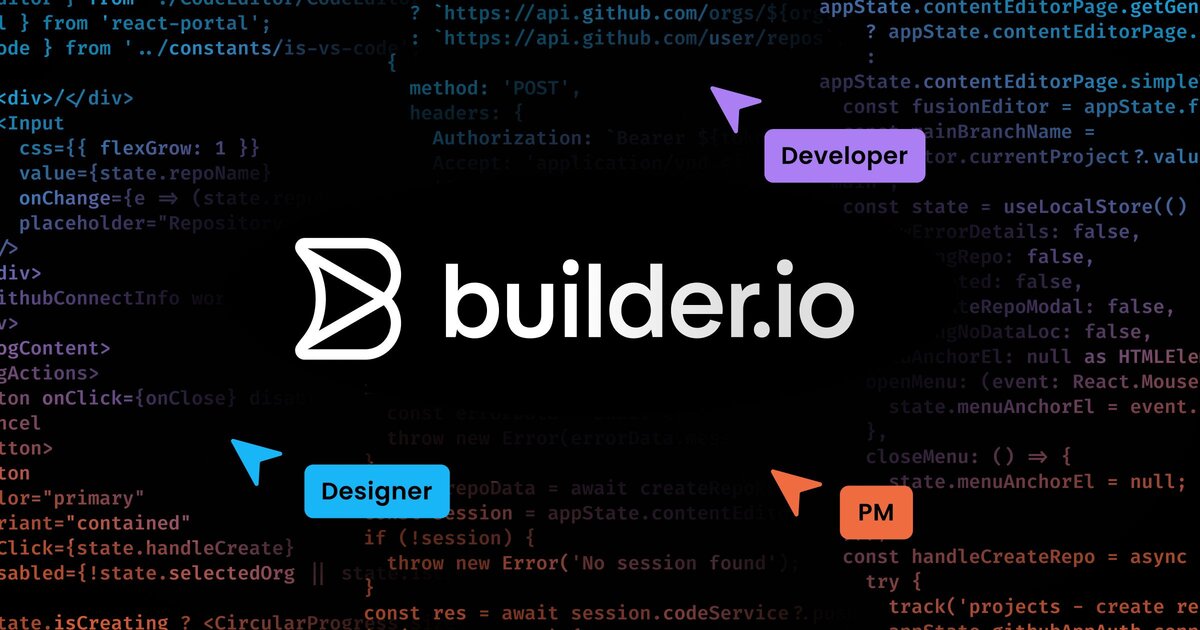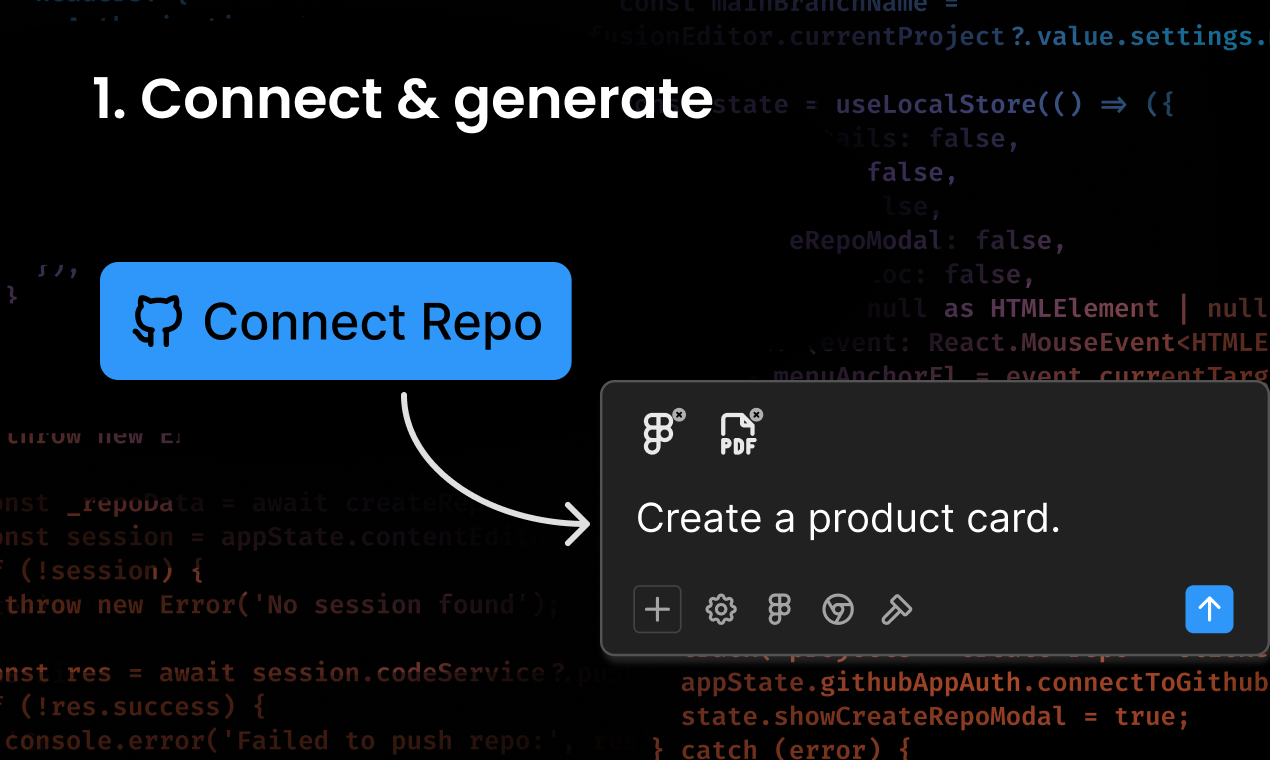
Table of Contents
Overview
In the fast-evolving world of front-end development, tools that bridge the gap between design and code are invaluable. Enter Builder.io, an innovative AI-powered visual development platform designed to revolutionize how UI is built. Builder.io connects directly to your existing codebase, intelligently learns your design system and APIs, and uses AI to generate production-ready code. The platform consists of two main products: Builder Develop for AI-powered design-to-code workflows, and Builder Publish for visual content management and optimization. Together, they streamline the entire development workflow by integrating with GitHub repositories, automating pull request creation, and providing live preview environments.
Key Features
Builder.io offers powerful features designed to accelerate your development process through its integrated platform:
- GitHub Integration: Connects directly to your GitHub repositories through Builder Projects, ensuring seamless integration into existing development workflows and version control systems.
- AI Code Generation: Leverages artificial intelligence to generate production-ready code from Figma designs, significantly reducing manual coding effort while respecting your existing design systems and coding standards.
- Design System Learning: Intelligently analyzes and learns your established design systems, components, and APIs to ensure all generated code maintains consistency with your brand guidelines and technical specifications.
- Visual Development Environment: Provides an intuitive visual interface where both developers and designers can create, edit, and optimize web experiences using drag-and-drop functionality combined with AI assistance.
- Automated Workflow Management: Streamlines development by automatically creating branches, generating pull requests, and deploying live preview environments for every change, enabling efficient code review and collaboration.
- Multi-Framework Support: Generates code for various frameworks including React, Vue, Angular, Svelte, and mobile platforms, with support for different styling approaches like Tailwind CSS and CSS modules.
- Component Mapping: Creates direct relationships between Figma design components and actual code components in your repository, ensuring AI-generated code reuses existing components rather than creating duplicates.
How It Works
Builder.io operates through an integrated ecosystem that combines visual development with automated code generation. The process begins when you connect your GitHub repository to Builder Projects, establishing a foundation for AI-assisted development. The platform analyzes your existing codebase, design systems, and component libraries to understand your development patterns and standards.
Using Builder Develop, teams can import Figma designs and leverage AI to generate production-ready code that follows their established conventions. The AI understands component relationships, coding standards, and project architecture through custom instructions and automatic codebase analysis. Meanwhile, Builder Publish enables teams to create and manage content visually, with changes automatically syncing to your codebase through the integrated workflow.
Throughout this process, Builder automates the technical overhead of modern development by handling branch creation, pull request generation, and deployment of preview environments, allowing teams to focus on building features rather than managing development infrastructure.
Use Cases
Builder.io serves diverse development scenarios and team compositions:
- Design-to-Code Acceleration: Rapidly convert Figma designs into production-ready components, dramatically reducing the time between design completion and implementation while maintaining code quality standards.
- Component Library Development: Build and maintain design system components using AI assistance, ensuring consistency across applications while enabling rapid iteration and refinement.
- Cross-Functional Team Collaboration: Bridge communication gaps between designers and developers by providing a shared platform where design changes can be immediately reflected in code and vice versa.
- Content Management and Optimization: Enable non-technical team members to create and manage web content using visual tools while maintaining developer control over underlying code architecture.
- Rapid Prototyping and Testing: Quickly build interactive prototypes with production-quality code, allowing for faster validation of concepts and user testing without sacrificing implementation quality.
Advantages and Considerations
Advantages
- Accelerated Development Cycles: Significantly reduces time from design to deployment by automating routine coding tasks and eliminating manual translation of design specifications.
- Enhanced Team Collaboration: Provides a unified platform where designers and developers can work together effectively, reducing miscommunication and iteration cycles.
- Code Quality Maintenance: Generates code that follows your team’s established patterns and standards, ensuring consistency and maintainability across projects.
- Seamless Workflow Integration: Fits naturally into existing development processes through deep GitHub integration and support for modern development practices.
Considerations
- Learning Curve for Teams: Organizations may need time to adapt workflows and train team members on the integrated visual development approach.
- AI-Generated Code Review: While production-ready, AI-generated code still benefits from developer review to ensure optimal performance and adherence to specific project requirements.
- Legacy System Integration: Highly customized or legacy codebases may require additional configuration and adaptation to work effectively with the platform.
- Subscription Cost Scaling: Usage-based pricing may increase costs for larger teams or projects with extensive development activity.
Competitive Landscape
Builder.io distinguishes itself in the visual development space through its comprehensive approach to AI-assisted development:
Vercel AI SDK: While Vercel focuses primarily on deployment optimization and AI integration for various development tasks, it lacks Builder.io’s visual development interface and automated design-to-code capabilities. Builder.io provides a more complete solution for teams looking to streamline the entire design-to-development workflow.
Locofy: Shares similar design-to-code conversion capabilities but focuses primarily on rapid prototyping from Figma designs. Builder.io offers broader functionality including content management, multi-framework support, and deeper GitHub integration for production development workflows.
Framer: Excels in design fidelity and interactive prototyping, particularly for marketing sites and design presentations. However, Builder.io provides stronger developer-focused features, production code generation, and integration capabilities for teams building complex applications.
Technical Implementation
Builder.io operates as a comprehensive visual development platform with two main products serving different aspects of the development lifecycle. Builder Develop focuses on AI-powered code generation from designs, while Builder Publish provides visual content management capabilities. Both products integrate with your existing technology stack through SDKs, APIs, and direct codebase connections.
The platform supports enterprise-grade security with SOC 2 Type II compliance and offers flexible data handling policies based on subscription tiers. Teams can maintain full control over their code repositories while leveraging Builder’s AI capabilities to accelerate development processes.
Final Thoughts
Builder.io represents a significant advancement in visual development platforms, offering a compelling solution for teams seeking to modernize their development workflows. By combining AI-powered code generation with visual development tools and seamless GitHub integration, it addresses the growing need for faster, more collaborative development processes. While teams should consider integration complexity and workflow adaptation requirements, Builder.io’s comprehensive approach to bridging design and development makes it a valuable tool for organizations looking to accelerate their digital product development while maintaining code quality and team collaboration standards.

